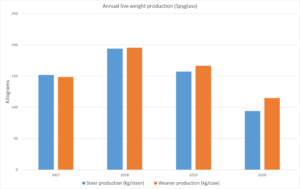Achievable cow productivity
Too often when the question is asked, ‘How is your beef breeding herd going?’ the response is usually about weaning rates which only partially answers the question.
If profit is driven by live weight production, its value and the cost of production, then perhaps better questions are ‘How many kilograms of live weight do you produce annually per cow (or hectare)?’ and secondly ‘is cow live weight production at an achievable level?’
This study is validating a hypothesis from the Northern Australian Beef Fertility project (CashCow) that achievable cow productivity (measured as weaner production – kg weaned per cow retained) should be at least equal to annual steer growth, when grazing under the same conditions. If weaner production is lower than steer growth, it indicates there is a performance issue (growth, reproduction or mortality) that warrants investigation. Therefore, using annual steer growth as an indicator of what breeding cows could be producing should provide a useful guide for beef producers.
To investigate this theory, testing has continued at Spyglass Research Facility where 10 young monitor steers (changed annually) are grazing with a mob of ~300 mature cows.
The measurements are simple. At each pregnancy diagnosis/final weaning muster we compare annual steer growth with weaner production using:
- Number of cows retained from the previous year’s pregnancy diagnosis/final weaning muster
- Number of calves weaned each year and their average weight
- Annual weight gain of steers
What have we found?
The study group of cattle have been monitored for the past four years, with another three planned. Results to date support the concept that steer growth could be used as a benchmark for achievable cow productivity. The current data’s trend is aligning with the Cashcow project data, with cow production slightly higher than steer growth.
Where to from here?
We are continuing the monitoring as it is quite simple and, if we can validate the theory, it will be of enormous value to the industry for graziers to more accurately identify how well their breeding cows are performing and identify where improvements can be made. In addition, results from stocking rate trials using steers, such as the Wambiana Grazing Trial, become directly relevant to grazing management of breeding herds.
When: 2017 to 2023
Where: Spyglass Research Facility
Contact: Dave Smith E: dave.smith@daf.qld.gov.au or P: 0409 580 357
Collaborators: Department of Agriculture and Fisheries through CBRC extension support.
Useful links: Linking Wambiana trial findings with decisions in breeding cattle (PDF, 1MB)